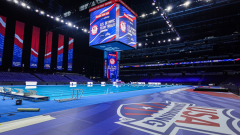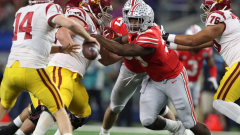Ryan Murphy spends a lot of time looking up at the ceiling. More than the average swimmer, but it’s what backstrokers do. They try to swim straight, count their strokes and note the flags, signaling the wall is coming up fast.
So when he learned U.S. Olympic swimming trials for the 2024 Paris Games would be at Lucas Oil Stadium from June 15-23, he wondered what he’d be looking at. And if the giant windows above each end zone at the Indianapolis Colts’ venue could impact swimmers.
“Being in an NFL stadium is going to be wild for us because it’s just a very far way to look,” the two-time Olympian told For The Win.
“I asked if the sun sets on the same side of the stadium where the pool is going to be, and I think they said that it sets on the opposite side.”
It’s a valid concern, considering this is the first time trials have been at a football stadium after a basketball arena in Omaha hosted the last four. And while USA Swimming is well-versed in building temporary pools, Lucas Oil Stadium offers the chance for more of everything — more space and amenities for athletes, more fans, more pizzazz to match the stakes of the meet.
Three pools. One NFL Stadium. 𝗢𝗻𝗲 #𝗦𝘄𝗶𝗺𝗧𝗿𝗶𝗮𝗹𝘀𝟮𝟰.
Action takes place June 15-23 in @LucasOilStadium and on @NBCOlympics to decide the U.S. Olympic Swim Team this summer.#SwimTrials24 | https://t.co/FLouSBuUuN | @teamusa pic.twitter.com/b54uVUqIVI
— USA Swimming (@USASwimming) June 5, 2024
At one time, trials at a big venue like CHI Health Center Omaha was considered groundbreaking for the sport. But with tickets selling quickly, trials had simply outgrown the building, USA Swimming chief commercial officer Shana Ferguson said.
Now for a couple weeks, Lucas Oil Stadium is the nation’s largest natatorium, simultaneously providing an intimate atmosphere in a significantly larger venue.
Yet more space for trials also comes with more challenges, both logistically and in ensuring pool conditions are technically flawless in a controlled environment, including blacking out the windows (and assuaging Murphy’s concerns).
RELATED: 12 photos and videos of Olympic trials pools being built in Lucas Oil Stadium
How do you fit an Olympic Trials pool inside an NFL Stadium?
USA Swimming built three pools: a standardized 10-lane, 50-meter competition pool and two connected warmup pools — another 10-lane, 50-meter one and a seven-lane, 25-meter one.
The overall cost of trials is split between USA Swimming and Indiana Sports Corp, with Ferguson saying it’s “deep into seven figures” and Patrick Talty, president of Indiana Sports Corp, noting sponsorship and ticket sales help offset the price tag. However, both declined to provide a specific number.

Beginning of pool construction at Lucas Oil Stadium for 2024 U.S. Olympic swimming trials (Photo courtesy of USA Swimming)
The competition pool is on the stadium’s south side with a huge curtain hanging around the 50-yard line, separating the competition pool from the warmup ones. About 20 rows of seats on the north side are on wheels and were relocated to the south side to make the competition pool more of a round arena instead of a horseshoe, Ferguson said.
Organizers are expecting to hit the 30,000 capacity Saturday for the first day of trials, which would break the attendance world record for an indoor swim meet. The current mark, according to USA Swimming, is 25,000 from the 1936 Olympics. Even hoping for 20,000 fans each night is a huge difference compared with Omaha’s approximate sellable capacity at about 9,700, Ferguson said.
A bigger venue also opened the possibilities for more athlete amenities. In addition to more space to warm up and stretch, swimmers will have access to more massage tables and therapists and serenity suites for quiet relaxation. Coaches will have a designated wellness area too. There’s also room for more food options, including smoothie and coffee bars, along with space for a video game area, table tennis and cornhole.

Lucas Oil Stadium warmup pools for 2024 U.S. Olympic swimming trials (Photo courtesy of USA Swimming)
Perhaps most importantly — what Ferguson described as “the most popular amenity” at the 2016 trials — is space for swimmers to play with more therapy dogs, who were absent in 2021 because of COVID-19.
“We knew that that was the right package to elevate swimming and to [put] it on a grander stage,” Talty said, adding that the stadium was built to be flexible beyond Colts games. “To take it from a supercharged swim meet to really an event that people look forward to coming to every four years and really making it a big deal.”
How to build an Olympic pool from scratch inside Lucas Oil Stadium
What Lucas Oil Stadium was not built for is a plumbing and irrigation system that can handle 1.8 million gallons of water. But that’s necessary for three pools, and USA Swimming — along with its longtime contractors, including Myrtha Pools — knows how to build it.

Beginning of pool construction at Lucas Oil Stadium for 2024 U.S. Olympic swimming trials (Photo courtesy of USA Swimming)
“It’s essentially a very intricate above-ground pool” masquerading as an in-ground one with a plumbing system resembling “a grown up Erector Set,” Ferguson said.
You’d never know because 78,000 square feet of decking are built nearly 10 feet above the turf-less concrete ground, swallowing up eight rows of seats and concealing the two gigantic holding tanks for water filtration.
Throughout four weeks, nearly 200 workers built the pools. Hidden below deck are 5,000 linear feet of PVC piping creating a closed filtration loop with pumps capable of moving more than 8,500 gallons per minute, according to USA Swimming.
“I’ve talked to plenty of people about Olympic trials, and they’re all shocked that we could put a swimming pool inside of an NFL stadium,” Murphy said. “I don’t think many people are aware that you can build a pool above ground and just have all the piping on the floor and then build a temporary deck to make it look totally seamless.”
Water from the nearby White River was delivered to the stadium via fire hydrants and hoses with an assist from the Ind





